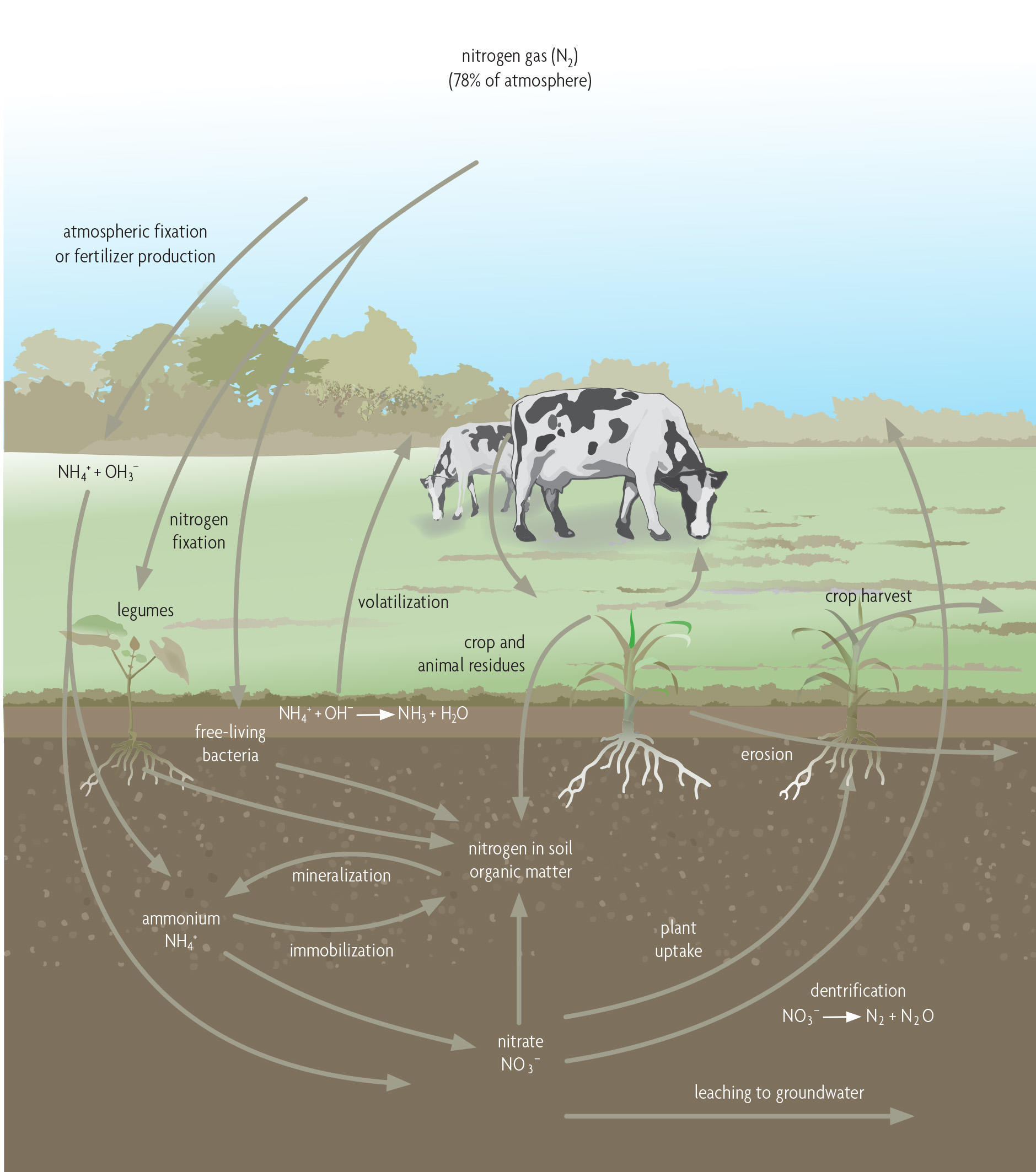The nitrogen cycle describes the many ways nitrogen can change forms in the environment, including changes that occur on farmland (Figure 10.9). There are several common nitrogen fertilizer formulations. Most are granules or liquids containing urea, ammonium or nitrate. Manures, legume cover crops or residual plant nutrients from previous crops also supply nitrogen. Under the warm, moist, aerobic conditions common during most southeastern cropping seasons, rapid mineralization and nitrification reactions will transform most nitrogen inputs to nitrate. Nitrates dissolve easily in water and can be lost through surface runoff, subsurface leaching or denitrification. Surface-applied nitrogen fertilizers can be changed into ammonia and lost to the atmosphere in a process referred to as volatilization. Assess the farm’s risk of losing nitrogen via these pathways and design a fertilization plan to minimize losses.
Volatilization Losses
Volatilization losses of ammonia are greatest with a high surface-soil pH and when nitrogen does not mix with the soil. Volatilization is of particular concern with conservation tillage systems since fertilizer is generally applied onto the soil surface or surface residue. Table 10.3 estimates likely percentages of fertilizer nitrogen losses for various soil, weather and fertilizer scenarios. For humid areas with a soil pH less than 7, expected ammonia volatilization losses are low, less than 5 percent, regardless of the nitrogen source or placement method. For sub-humid and dry areas with a soil pH less than 7, volatilization losses are a concern. In these areas, use nitrogen fertilizers with less urea and inject or incorporate urea-containing fertilizers. When the soil pH is greater than 7, incorporate all nitrogen fertilizers containing urea or ammonium regardless of climate. For either condition, urease inhibitors reduce the rate of conversion of urea to ammonium and may be effective at reducing volatilization losses when applied with fertilizers that contain urea. Using a urease inhibitor increases the likelihood that rainfall will move soluble urea into the soil profile before volatilization can occur.
Denitrification Losses
Denitrification is the conversion of nitrates to nitrogen gas. Denitrification losses are greatest in wet soils with high organic-matter content (Table 10.4). In fields with substantial risk of loss, optimize field drainage to reduce root-zone saturation. To reduce the likelihood of early-season nitrogen losses, apply most nitrogen fertilizer as a mid-season sidedress rather than applying all of it at planting. Consider the use of a nitrification inhibitor with urea-based or ammonium-based fertilizers. The duration of an inhibitor’s effectiveness can be limited in southeastern soils with higher organic-matter content [4].
Leaching Losses
Leaching losses refer to the flushing of nitrates down through the soil profile by rain or irrigation water. Leaching losses can be substantial in humid regions and vary greatly depending on soil, climate and management of fertilizer and irrigation. Even though water infiltration is greater with conservation tillage, studies from Tennessee [38], Iowa [34], Canada [12] and North Carolina [30] suggest that tillage has less influence on nitrate-leaching losses than crop rotation, nitrogen fertilizer rate and timing, and cover crops.
In fields with a substantial risk of leaching loss, apply most nitrogen fertilizer as a mid-season sidedress rather than applying all of it at planting. This application strategy results in a better match between nitrogen supply and crop demand, and reduces the risk of early-season nitrogen losses. Apply no more than the recommended amount of nitrogen, and plant small-grain winter cover crops such as rye to capture residual nitrate in the soil.
Surface Runoff
Surface runoff losses can be substantial if sheet or gully erosion is occurring or if nitrogen fertilizers are surface applied shortly before a rainfall. To reduce losses, use soil conservation best management practices (BMPs) including conservation tillage, no-till and cover crops; injecting or surface applying fertilizers in a band to facilitate passage through surface residue; and applying most nitrogen fertilizer as a mid-season sidedress when the established crop will control erosion and runoff.

